Superabsorbent Polymers: Innovations in Ecology, Environmental, and Diverse Applications
Abstract
:1. Introduction
2. Design of SAPs
2.1. Structural Characteristics of SAPs
2.2. Classification of SAPs
2.2.1. Polyacrylate-Based SAPs
2.2.2. Cellulose-Based SAPs
2.2.3. Chitosan-Based SAPs
2.2.4. Starch-Based SAPs
2.2.5. Protein-Based SAPs
2.2.6. Poly(aminoacid)-Based SAPs
2.2.7. Alginate-Based SAPs
2.2.8. Biopolymer-Based SAPs
2.2.9. Polycondensate-Based SAPs
3. Fabrication Technology of SAP
3.1. Bulk Polymerization
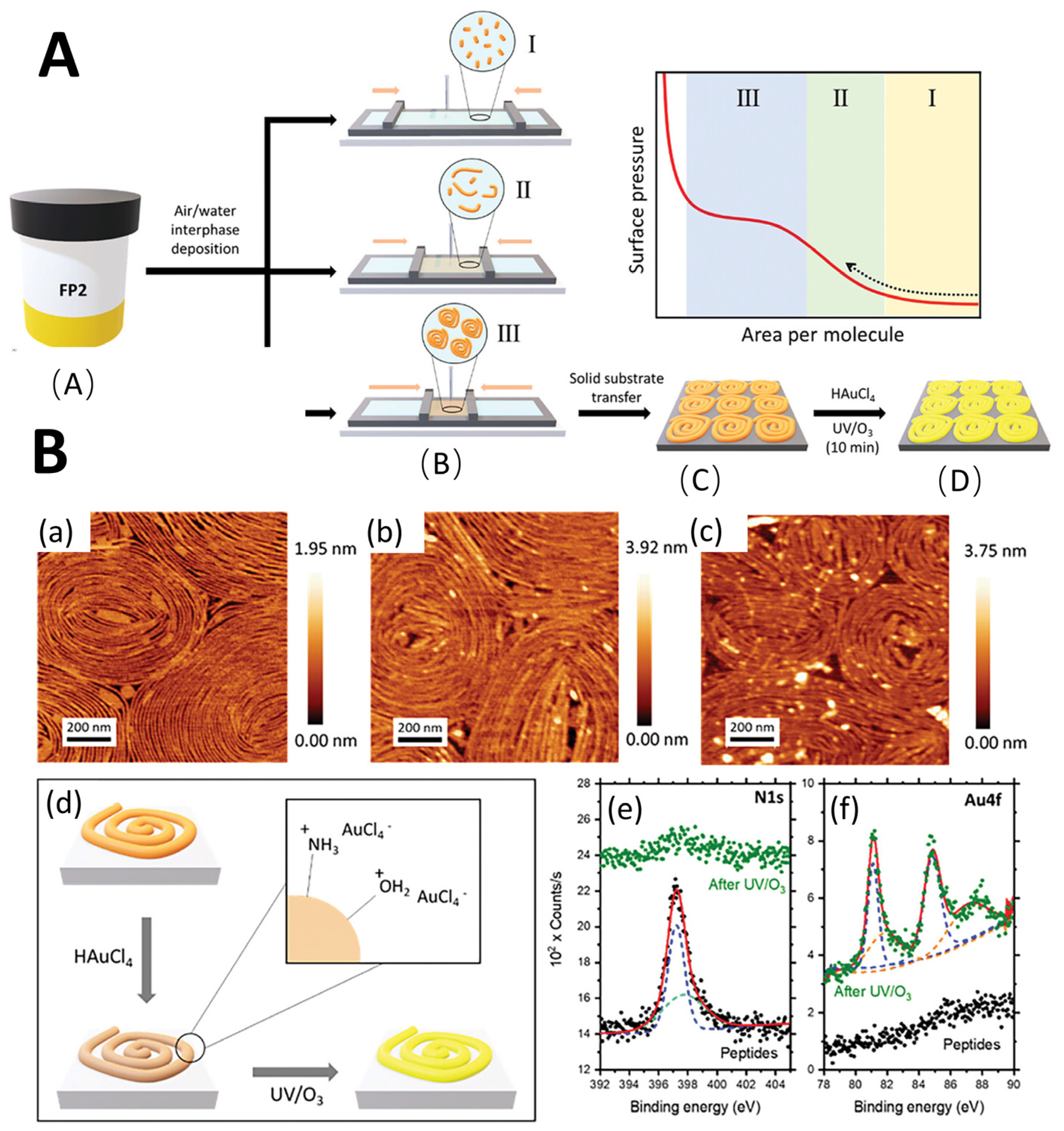
3.2. Solution Polymerization
3.3. Inverse Suspension Polymerization
3.4. Radiation Polymerization
3.5. Others
4. Ecological Applications
4.1. Agriculture
4.2. Desert Greening
4.3. Soil Domain
5. Conclusions and Outlook
Author Contributions
Funding
Data Availability Statement
Conflicts of Interest
References
- Supare, K.; Mahanwar, P.A. Starch-derived superabsorbent polymers in agriculture applications: An overview. Polym. Bull. 2022, 79, 5795–5824. [Google Scholar] [CrossRef]
- El Idrissi, A.; Dardari, O.; Metomo, F.N.N.N.; Essamlali, Y.; Akil, A.; Amadine, O.; Aboulhrouz, S.; Zahouily, M. Effect of sodium alginate-based superabsorbent hydrogel on tomato growth under different water deficit conditions. Int. J. Ofbiological Macromol. 2023, 253, 127229. [Google Scholar] [CrossRef] [PubMed]
- Khodadadi Dehkordi, D. Effect of superabsorbent polymer on soil and plants on steep surfaces. Water Environ. J. 2018, 32, 158–163. [Google Scholar] [CrossRef]
- Zhang, W.; Wang, P.; Deng, Y.; He, X.; Yang, X.; Chen, R.; Lei, Z. Preparation of superabsorbent polymer gel based on PVPP and its application in water-holding in sandy soil. J. Environ. Chem. Eng. 2021, 9, 106760. [Google Scholar] [CrossRef]
- Stahl, J.D.; Cameron, M.D.; Haselbach, J.; Aust, S.D. Biodegradation of superabsorbent polymers in soil. Environ. Sci. Pollut. Res. 2000, 7, 83–88. [Google Scholar] [CrossRef]
- Mahmoodzadeh, A.; Moghaddas, J.; Jarolmasjed, S.; Ebrahimi Kalan, A.; Edalati, M.; Salehi, R. Biodegradable cellulose-based superabsorbent as potent hemostatic agent. Chem. Eng. J. 2021, 418, 129252. [Google Scholar] [CrossRef]
- Geigenberger, P. Regulation of Starch Biosynthesis in Response to a Fluctuating Environment. Plant Physiol. 2011, 155, 1566–1577. [Google Scholar] [CrossRef]
- Łabowska, M.B.; Michalak, I.; Detyna, J. Methods of extraction, physicochemical properties of alginates and their applications in biomedical field—A review. Open Chem. 2019, 17, 738–762. [Google Scholar] [CrossRef]
- Nogueira, T.; Gonçalves, N.A.; Botan, R.; Wypych, F.; Lona, L.M.F. Layered double hydroxides as fillers in poly(l-lactide) nanocomposites, obtained by in situ bulk polymerization. Polim.-Cienc. E Tecnol. 2016, 26, 106–114. [Google Scholar] [CrossRef]
- Muhammad, M.; Tawfic, M.; Elsabbagh, A. Review of design and manufacturing of superabsorbent polymers (SAPs) hydrogel for agriculture in arid areas. Discov. Mater. 2024, 4, 43. [Google Scholar] [CrossRef]
- Yu, L.; Bi, J.; Song, Y.; Wang, M. Isotherm, Thermodynamics, and Kinetics of Methyl Orange Adsorption onto Magnetic Resin of Chitosan Microspheres. Int. J. Mol. Sci. 2022, 23, 13839. [Google Scholar] [CrossRef] [PubMed]
- Du, J.; Xu, K.; Yang, X.; Dong, Z.; Zhao, L. Removal of diclofenac sodium from aqueous solution using different ionic liquids functionalized tragacanth gum hydrogel prepared by radiation technique. Int. J. Biol. Macromol. 2024, 265, 130758. [Google Scholar] [CrossRef] [PubMed]
- Wach, R.A.; Adamus-Wlodarczyk, A.; Olejnik, A.K.; Matusiak, M.; Tranquilan-Aranilla, C.; Ulanski, P. Carboxymethylchitosan hydrogel manufactured by radiation-induced crosslinking as potential nerve regeneration guide scaffold. React. Funct. Polym. 2020, 152, 104588. [Google Scholar] [CrossRef]
- Zhao, S.; Fang, J.; Wang, Y.; Zhang, Y.; Zhou, Y.; Zhuo, S. Construction of three-dimensional mesoporous carbon nitride with high surface area for efficient visible-light-driven hydrogen evolution. J. Colloid. Interface Sci. 2020, 561, 601–608. [Google Scholar] [CrossRef]
- Zohuriaan-Mehr, M.J.; Omidian, H.; Doroudiani, S.; Kabiri, K. Advances in non-hygienic applications of superabsorbent hydrogel materials. J. Mater. Sci. 2010, 45, 5711–5735. [Google Scholar] [CrossRef]
- Laftah, W.A.; Hashim, S.; Ibrahim, A.N. Polymer Hydrogels: A Review. Polym.-Plast. Technol. Eng. 2011, 50, 1475–1486. [Google Scholar] [CrossRef]
- Chang, L.; Xu, L.; Liu, Y.; Qiu, D. Superabsorbent polymers used for agricultural water retention. Polym. Test. 2021, 94, 107021. [Google Scholar] [CrossRef]
- Chen, J.; Wu, J.; Raffa, P.; Picchioni, F.; Koning, C.E. Superabsorbent Polymers: From long-established, microplastics generating systems, to sustainable, biodegradable and future proof alternatives. Prog. Polym. Sci. 2022, 125, 101475. [Google Scholar] [CrossRef]
- Cheng, B.; Pei, B.; Wang, Z.; Hu, Q. Advances in chitosan-based superabsorbent hydrogels. RSC Adv. 2017, 7, 42036–42046. [Google Scholar] [CrossRef]
- Rivas, B.L.; Pereira, E.D.; Palencia, M.; Sánchez, J. Water-soluble functional polymers in conjunction with membranes to remove pollutant ions from aqueous solutions. Prog. Polym. Sci. 2011, 36, 294. [Google Scholar] [CrossRef]
- Sharma, K.; Kumar, V.; Kaith, B.S.; Kumar, V.; Som, S.; Kalia, S.; Swart, H.C. Synthesis, characterization and water retention study of biodegradable Gum ghatti-poly(acrylic acid–aniline) hydrogels. Polym. Degrad. Stab. 2015, 111, 20–31. [Google Scholar] [CrossRef]
- Fujita, S.; Tazawa, T.; Kono, H. Preparation and Enzyme Degradability of Spherical and Water-Absorbent Gels from Sodium Carboxymethyl Cellulose. Gels 2022, 8, 321. [Google Scholar] [CrossRef] [PubMed]
- Maijan, P.; Chantarak, S. Synthesis and characterization of highly durable and reusable superabsorbent core–shell particles. Polym. Eng. Sci. 2020, 60, 306–313. [Google Scholar] [CrossRef]
- Zhang, C.; García Meza, J.V.; Zhou, K.; Liu, J.; Song, S.; Zhang, M.; Meng, D.; Chen, J.; Xia, L.; Xiheng, H. Superabsorbent polymer used for saline-alkali soil water retention. J. Taiwan. Inst. Chem. Eng. 2023, 145, 104830. [Google Scholar] [CrossRef]
- Li, J.; Zhu, Y.; Liu, M.; Liu, Z.; Zhou, T.; Liu, Y.; Cheng, D. Network interpenetrating slow-release nitrogen fertilizer based on carrageenan and urea: A new low-cost water and fertilizer regulation carrier. Int. J. Biol. Macromol. 2023, 242, 124858. [Google Scholar] [CrossRef]
- Jancar, J.; Skarpa, P.; Abdel-Mohsen, A.M. Fertilizer technology based on optimized nitrogen release from urea-loaded natural superabsorbent carriers. Soil Use Manag. 2023, 39, 1583–1599. [Google Scholar] [CrossRef]
- Jyotish, J.; Nayak, R.; Tripathy, D.; Moharana, S.; Mahaling, R.N. Starch-Based Superabsorbent Polymer. In Bio-Based Superabsorbents: Recent Trends, Types, Applications and Recycling; Pradhan, S., Mohanty, S., Eds.; Springer Nature: Singapore, 2023; pp. 115–143. [Google Scholar]
- Ma, X.; Wen, G. Development history and synthesis of super-absorbent polymers: A review. J. Polym. Res. 2020, 27, 136. [Google Scholar] [CrossRef]
- Snoeck, D.; Velasco, L.F.; Mignon, A.; Van Vlierberghe, S.; Dubruel, P.; Lodewyckx, P.; De Belie, N. The effects of superabsorbent polymers on the microstructure of cementitious materials studied by means of sorption experiments. Cem. Concr. Res. 2015, 77, 26–35. [Google Scholar] [CrossRef]
- Snoeck, D.; Tittelboom, K.; Steuperaert, S.; Dubruel, P.; De Belie, N. Self-healing cementitious materials by the combination of microfibres and superabsorbent polymers. J. Intell. Mater. Syst. Struct. 2014, 25, 13–24. [Google Scholar] [CrossRef]
- Kalinowski, M.; Woyciechowski, P. Chloride Diffusion in Concrete Modified with Polyacrylic Superabsorbent Polymer (SAP) Hydrogel—The Influence of the Water-to-Cement Ratio and SAP-Entrained Water. Materials 2021, 14, 4064. [Google Scholar] [CrossRef]
- Zhang, Y.; Zhao, M.; Cheng, Q.; Wang, C.; Li, H.; Han, X.; Fan, Z.; Su, G.; Pan, D.; Li, Z. Research progress of adsorption and removal of heavy metals by chitosan and its derivatives: A review. Chemosphere 2021, 279, 130927. [Google Scholar] [CrossRef] [PubMed]
- Zohuriaan-Mehr, M.J.; Pourjavadi, A.; Salimi, H.; Kurdtabar, M. Protein- and homo poly(amino acid)-based hydrogels with super-swelling properties. Polym. Adv. Technol. 2009, 20, 655–671. [Google Scholar] [CrossRef]
- Sennakesavan, G.; Mostakhdemin, M.; Dkhar, L.K.; Seyfoddin, A.; Fatihhi, S.J. Acrylic acid/acrylamide based hydrogels and its properties—A review. Polym. Degrad. Stab. 2020, 180, 109308. [Google Scholar] [CrossRef]
- McNeill, I.C.; Sadeghi, S.M.T. Thermal stability and degradation mechanisms of poly(acrylic acid) and its salts: Part 1—Poly(acrylic acid). Polym. Degrad. Stab. 1990, 29, 233–246. [Google Scholar] [CrossRef]
- Grzybek, P.; Jakubski, Ł.; Dudek, G. Neat Chitosan Porous Materials: A Review of Preparation, Structure Characterization and Application. Int. J. Mol. Sci. 2022, 23, 9932. [Google Scholar] [CrossRef]
- Guo, Y.; Guo, R.; Shi, X.; Lian, S.; Zhou, Q.; Chen, Y.; Liu, W.; Li, W. Synthesis of cellulose-based superabsorbent hydrogel with high salt tolerance for soil conditioning. Int. J. Biol. Macromol. 2022, 209, 1169–1178. [Google Scholar] [CrossRef]
- Qi, Z.; Hu, X. Waterabsorbency of super absorbent polymer based on flexible polymeric network. Eur. Polym. J. 2022, 166, 111045. [Google Scholar] [CrossRef]
- Ahmed, W.; Angel, N.; Edson, J.; Bibby, K.; Bivins, A.; O’Brien, J.W.; Choi, P.M.; Kitajima, M.; Simpson, S.L.; Li, J. First confirmed detection of SARS-CoV-2 in untreated wastewater in Australia: A proof of concept for the wastewater surveillance of COVID-19 in the community. Sci. Total Environ. 2020, 728, 138764. [Google Scholar] [CrossRef]
- Thakur, S.; Arotiba, O.A. Synthesis, swelling and adsorption studies of a pH-responsive sodium alginate–poly(acrylic acid) superabsorbent hydrogel. Polym. Bull. 2018, 75, 4587–4606. [Google Scholar] [CrossRef]
- Yang, H.; Liu, J.; Wu, L.; Wang, W. Influence of reswollen superabsorbent polymers on the corrosion behavior of steel fibers in cracked mortars exposed to NaCl solutions. Constr. Build. Mater. 2021, 299, 124283. [Google Scholar] [CrossRef]
- Jiang, C.; Zhang, X.; Zhang, X.; Li, X.; Xu, S.; Li, Y. Integrating Bioinspired Natural Adhesion Mechanisms into Modified Polyacrylate Latex Pressure-Sensitive Adhesives. Polymers 2024, 16, 2404. [Google Scholar] [CrossRef] [PubMed]
- Kefeli, T.Y.; Korolev, G.V.; Filippovskaya, Y.M. Synthesis and polymerization of polyacrylic esters. J. Polym. Sci. 1961, 52, 169–177. [Google Scholar] [CrossRef]
- Schröfl, C.; Erk, K.A.; Siriwatwechakul, W.; Wyrzykowski, M.; Snoeck, D. Recent progress in superabsorbent polymers for concrete. Cem. Concr. Res. 2022, 151, 106648. [Google Scholar] [CrossRef]
- Yang, Y.; Liang, Z.; Zhang, R.; Zhou, S.; Yang, H.; Chen, Y.; Zhang, J.; Yin, H.; Yu, D. Research Advances in Superabsorbent Polymers. Polymers 2024, 16, 501. [Google Scholar] [CrossRef] [PubMed]
- Wang, C.; Guan, S.; Guo, J.; Zhao, M.; Zhou, Y.; Zhao, Y. Preparation and properties of UV cation-initiated self-crosslinking acrylate pressure-sensitive adhesive without reactive diluent. Prog. Org. Coat. 2023, 181, 107572. [Google Scholar] [CrossRef]
- Galib, R.H.; Tian, Y.; Lei, Y.; Dang, S.; Li, X.; Yudhanto, A.; Lubineau, G.; Gan, Q. Atmospheric-moisture-induced polyacrylate hydrogels for hybrid passive cooling. Nat. Commun. 2023, 14, 6707. [Google Scholar] [CrossRef]
- Arredondo, R.; Yuan, Z.; Sosa, D.; Johnson, A.; Beims, R.F.; Li, H.; Wei, Q.; Xu, C.C. Performance of a novel, eco-friendly, cellulose-based superabsorbent polymer (Cellulo-SAP): Absorbency, stability, reusability, and biodegradability. Can. J. Chem. Eng. 2023, 101, 1762–1771. [Google Scholar] [CrossRef]
- Hao, Y.; Qu, J.; Tan, L.; Liu, Z.; Wang, Y.; Lin, T.; Yang, H.; Peng, J.; Zhai, M. Synthesis and property of superabsorbent polymer based on cellulose grafted 2-acrylamido-2-methyl-1-propanesulfonic acid. Int. J. Biol. Macromol. 2023, 233, 123643. [Google Scholar] [CrossRef]
- Zhou, Y.; Fu, S.; Zhang, L.; Zhan, H. Superabsorbent nanocomposite hydrogels made of carboxylated cellulose nanofibrils and CMC-g-p(AA-co-AM). Carbohydr. Polym. 2013, 97, 429–435. [Google Scholar] [CrossRef]
- Ghorbani, S.; Eyni, H.; Bazaz, S.R.; Nazari, H.; Asl, L.S.; Zaferani, H.; Kiani, V.; Mehrizi, A.A.; Soleimani, M. Hydrogels Based on Cellulose and its Derivatives: Applications, Synthesis, and Characteristics. Polym. Sci. Ser. A 2018, 60, 707–722. [Google Scholar] [CrossRef]
- Dodangeh, F.; Nabipour, H.; Rohani, S.; Xu, C. Applications, challenges and prospects of superabsorbent polymers based on cellulose derived from lignocellulosic biomass. Bioresour. Technol. 2024, 408, 131204. [Google Scholar] [CrossRef]
- Kundu, R.; Mahada, P.; Chhirang, B.; Das, B. Cellulose hydrogels: Green and sustainable soft biomaterials. Curr. Res. Green Sustain. Chem. 2022, 5, 100252. [Google Scholar] [CrossRef]
- Cheng, S.; Liu, X.; Zhen, J.; Lei, Z. Preparation of superabsorbent resin with fast water absorption rate based on hydroxymethyl cellulose sodium and its application. Carbohydr. Polym. 2019, 225, 115214. [Google Scholar] [CrossRef]
- Ismaeilimoghadam, S.; Jonoobi, M.; Ashori, A.; Shahraki, A.; Azimi, B.; Danti, S. Interpenetrating and semi-interpenetrating network superabsorbent hydrogels based on sodium alginate and cellulose nanocrystals: A biodegradable and high-performance solution for adult incontinence pads. Int. J. Biol. Macromol. 2023, 253, 127118. [Google Scholar] [CrossRef]
- Hong, F.; Qiu, P.; Wang, Y.; Ren, P.; Liu, J.; Zhao, J.; Gou, D. Chitosan-based hydrogels: From preparation to applications, a review. Food Chem. X 2024, 21, 101095. [Google Scholar] [CrossRef]
- Elizalde-Cárdenas, A.; Ribas-Aparicio, R.M.; Rodríguez-Martínez, A.; Leyva-Gómez, G.; Ríos-Castañeda, C.; González-Torres, M. Advances in chitosan and chitosan derivatives for biomedical applications in tissue engineering: An updated review. Int. J. Biol. Macromol. 2024, 262, 129999. [Google Scholar] [CrossRef]
- Harugade, A.; Sherje, A.P.; Pethe, A. Chitosan: A review on properties, biological activities and recent progress in biomedical applications. React. Funct. Polym. 2023, 191, 105634. [Google Scholar] [CrossRef]
- Kankariya, Y.; Chatterjee, B. Biomedical Application of Chitosan and Chitosan Derivatives: A Comprehensive Review. Curr. Pharm. Des. 2023, 29, 1311–1325. [Google Scholar] [CrossRef]
- Sorokin, A.; Lavlinskaya, M. Synthesis of the superabsobents enriched in chitosan derivatives with excellent water absorption properties. Polym. Bull. 2022, 79, 407–427. [Google Scholar] [CrossRef]
- Alves, N.M.; Mano, J.F. Chitosan derivatives obtained by chemical modifications for biomedical and environmental applications. Int. J. Biol. Macromol. 2008, 43, 401–414. [Google Scholar] [CrossRef]
- Wang, X.; Huang, L.; Zhang, C.; Deng, Y.; Xie, P.; Liu, L.; Cheng, J. Research advances in chemical modifications of starch for hydrophobicity and its applications: A review. Carbohydr. Polym. 2020, 240, 116292. [Google Scholar] [CrossRef]
- Cornejo-Ramírez, Y.I.; Martínez-Cruz, O.; Del Toro-Sánchez, C.L.; Wong-Corral, F.J.; Borboa-Flores, J.; Cinco-Moroyoqui, F.J. The structural characteristics of starches and their functional properties. CyTA—J. Food 2018, 16, 1003–1017. [Google Scholar] [CrossRef]
- Hezarkhani, M.; Yilmaz, E. Pullulan modification via poly(N-vinylimidazole) grafting. Int. J. Biol. Macromol. 2019, 123, 149–156. [Google Scholar] [CrossRef]
- Parvathy, P.C.; Jyothi, A.N.; John, K.S.; Sreekumar, J. Cassava Starch Based Superabsorbent Polymer as Soil Conditioner: Impact on Soil Physico-Chemical and Biological Properties and Plant Growth. CLEAN—Soil Air Water 2014, 42, 1610–1617. [Google Scholar] [CrossRef]
- Bai, W.; Ji, B.; Fan, L.; Peng, Q.; Liu, Q.; Song, J. Preparation and Characterization of a Novel Cassava Starch-Based Phosphorus Releasing Super-Absorbent Polymer, and Optimization of the Performance of Water Absorption and Phosphorus Release. Polymers 2023, 15, 1233. [Google Scholar] [CrossRef]
- Akhter, J.; Mahmood, K.; Malik, K.A.; Mardan, A.; Ahmad, M.; Iqbal, M.M. Effects of hydrogel amendment on water storage of sandy loam and loam soils and seedling growth of barley, wheat and chickpea. Plant Soil Environ. 2004, 50, 463–469. [Google Scholar] [CrossRef]
- Abo-Sedera, S. Conditioning Effect of Composts and Acrylamide Hydrogels on a Sandy Calcareous Soil. II-Physico-bio-chemical Properties of the Soil. Int. J. Agric. Biol. 2006, 8, 876–884. [Google Scholar]
- El-Hady, O.A.; Abd El-Kader, A.; Shafi, A.M. Physico-bio-chemical properties of sandy soil conditioned with acrylamide hydrogels after cucumber plantation. Aust. J. Basic Appl. Sci. 2009, 3, 3145–3151. [Google Scholar]
- Yang, X.; Chen, X.; Ge, Q.; Li, B.; Tong, Y.; Zhang, A.; Li, Z.; Kuang, T.; Lu, C. Tolerance of photosynthesis to photoinhibition, high temperature and drought stress in flag leaves of wheat: A comparison between a hybridization line and its parents grown under field conditions. Plant Sci. 2006, 171, 389–397. [Google Scholar] [CrossRef]
- Haji, N.; Asl, H.; Aghdam, A.M.; Farahani, H.A.; Hosseini, N.M.; Far, M.R. Three Forage Yield and Its Components Under Water Deficit Condition on Delay Cropping in Khoy Zone (Iran). Adv. Environ. Biol. 2011, 5, 847–852. [Google Scholar]
- Yazdani, F.; Allahdadi, I.; Akbari, G.A. Impact of superabsorbent polymer on yield and growth analysis of soybean (Glycine max L.) under drought stress condition. Pak. J. Biol. Sci. 2007, 10, 4190–4196. [Google Scholar] [CrossRef] [PubMed]
- Milner-White, E.J. Protein three-dimensional structures at the origin of life. Interface Focus 2019, 9, 20190057. [Google Scholar] [CrossRef]
- Ljung, F.; André, I. ZEAL: Protein structure alignment based on shape similarity. Bioinformatics 2021, 37, 2874–2881. [Google Scholar] [CrossRef]
- Cuadri, A.A.; Romero, A.; Bengoechea, C.; Guerrero, A. The Effect of Carboxyl Group Content on Water Uptake Capacity and Tensile Properties of Functionalized Soy Protein-Based Superabsorbent Plastics. J. Polym. Environ. 2018, 26, 2934–2944. [Google Scholar] [CrossRef]
- Fan, J.; He, X.; Zhou, X.; Li, S.; Yang, Y. Effect of Amino Acid Types on the Mechanical and Antimicrobial Properties of Amino Acid-Based Polyionic Liquid Hydrogels. Macromol. Rapid Commun. 2024, 45, e2300689. [Google Scholar] [CrossRef]
- Lu, D.; Zhang, Y.; Li, Y.; Luo, C.; Wang, X.; Guan, X.; Ma, H.; Zhao, X.; Wei, Q.; Lei, Z. Preparation and properties of reversible hydrogels based on triblock poly(amino acid)s with tunable pH-responsivity across a broad range. J. Polym. Sci. Part A Polym. Chem. 2017, 55, 207–212. [Google Scholar] [CrossRef]
- Zhao, J.; Wei, J.; Wang, X.; Cao, H. Coupling fermentation of glutamic acid and γ-polyglutamic acid and preparation of poly(amino acid) superabsorbent polymers. BMC Biotechnol. 2023, 23, 47. [Google Scholar] [CrossRef]
- Shin, H.J.; Cho, H.U.; Park, J.M. Alginate as a Soil Conditioner: Properties, Mechanisms, and Agricultural Applications. Biotechnol. Bioprocess Eng. 2023, 28, 734–749. [Google Scholar] [CrossRef]
- Gheorghita Puscaselu, R.; Lobiuc, A.; Dimian, M.; Covasa, M. Alginate: From Food Industry to Biomedical Applications and Management of Metabolic Disorders. Polymers 2020, 12, 2417. [Google Scholar] [CrossRef]
- Mignon, A.; Vermeulen, J.; Graulus, G.-J.; Martins, J.; Dubruel, P.; De Belie, N.; Van Vlierberghe, S. Characterization of methacrylated alginate and acrylic monomers as versatile SAPs. Carbohydr. Polym. 2017, 168, 44–51. [Google Scholar] [CrossRef]
- Korzhikov-Vlakh, V.; Krylova, M.; Sinitsyna, E.; Ivankova, E.; Averianov, I.; Tennikova, T.B. Hydrogel Layers on the Surface of Polyester-Based Materials for Improvement of Their Biointeractions and Controlled Release of Proteins. Polymers 2016, 8, 418. [Google Scholar] [CrossRef]
- He, T.; Lv, S.; Wei, D.; Feng, R.; Yang, J.; Yan, Y.; Liu, L.; Wu, L. Photothermal Conversion of Hydrogel-Based Biomaterial. Chem. Rec. 2023, 23, e202300184. [Google Scholar] [CrossRef]
- Bora, A.; Karak, N. Starch and itaconic acid-based superabsorbent hydrogels for agricultural application. Eur. Polym. J. 2022, 176, 111430. [Google Scholar] [CrossRef]
- Aday, A.N.; Osio-Norgaard, J.; Foster, K.E.O.; Srubar, W.V. Carrageenan-based superabsorbent biopolymers mitigate autogenous shrinkage in ordinary portland cement. Mater. Struct. 2018, 51, 37. [Google Scholar] [CrossRef]
- Sharma, S.; Dua, A.; Malik, A. Polyaspartic acid based superabsorbent polymers. Eur. Polym. J. 2014, 59, 363–376. [Google Scholar] [CrossRef]
- Zhao, Y.; Tan, T. Poly(aspartic acid) Super-Absorbent Resin Produced by Chemical Crosslinking and Physical Freeze/Thawing. Macromol. Chem. Phys. 2006, 207, 1297–1305. [Google Scholar] [CrossRef]
- De Grave, L.; Tenório Filho, J.R.; Snoeck, D.; Vynnytska, S.; De Belie, N.; Bernaerts, K.V.; Van Vlierberghe, S. Poly(aspartic acid) superabsorbent polymers as biobased and biodegradable additives for self-sealing of cementitious mortar. J. Sustain. Cem.-Based Mater. 2023, 12, 925–940. [Google Scholar] [CrossRef]
- Soleimani, M.; Khan, S.; Mendenhall, D.; Lau, W.; Winnik, M.A. Effect of molecular weight distribution on polymer diffusion during film formation of two-component high-/low-molecular weight latex particles. Polymer, 2012; 53, 2652–2663. [Google Scholar] [CrossRef]
- Dzulkurnain, N.A.; Hanifah, S.A.; Ahmad, A.; Mohamed, N.S. Characterization of Random Methacrylate Copolymers Synthesized Using Free-Radical Bulk Polymerization Method. Int. J. Electrochem. Sci. 2015, 10, 84–92. [Google Scholar] [CrossRef]
- Carraher, C.E., Jr. Polymer Chemistry, 6th ed.; Marcel Dekker, Inc.: New York, NY, USA, 2003; Chapter 8; pp. 344–348. [Google Scholar]
- Liu, P.; Zhu, L.; Guo, J.; Wang, A.; Zhao, Y.; Wang, Z. Palygorskite/polystyrene nanocomposites via facile in-situ bulk polymerization: Gelation and thermal properties. Appl. Clay Sci. 2014, 100, 95–101. [Google Scholar] [CrossRef]
- Pan, J.; Xue, X.; Wang, J.; Xie, H.; Wu, Z. Recognition property and preparation of Staphylococcus aureus protein A-imprinted polyacrylamide polymers by inverse-phase suspension and bulk polymerization. Polymer 2009, 50, 2365–2372. [Google Scholar] [CrossRef]
- Alvarez-Fernandez, A.; Pawar, N.; Sanchez-Puga, P.; Zaccai, N.R.; Maestro, A. Peptide-Guided Self-Assembly: Fabrication of Tailored Spiral-Like Nanostructures for Precise Inorganic Templating. Adv. Funct. Mater. 2025, 35, 2411061. [Google Scholar] [CrossRef]
- Li, Q.; Li, J.; Yu, W.; Wang, Z.; Li, J.; Feng, X.; Wang, J.; Shan, A. De novo design of a pH-triggered self-assembled β-hairpin nanopeptide with the dual biological functions for antibacterial and entrapment. J. Nanobiotechnology 2021, 19, 183. [Google Scholar] [CrossRef] [PubMed]
- Shao, Y.; Du, G.; Luo, B.; Liu, T.; Zhao, J.; Zhang, S.; Wang, J.; Chi, M.; Cai, C.; Liu, Y.; et al. A Tough Monolithic-Integrated Triboelectric Bioplastic Enabled by Dynamic Covalent Chemistry. Adv. Mater. 2024, 36, 2311993. [Google Scholar] [CrossRef] [PubMed]
- Kim, Y.; Uhrich, K.E. Synthesis and Characterization of 5-Aminosalicylic Acid Based Poly(anhydride-esters) by Solution Polymerization. J. Polym. Sci. A Polym. Chem. 2010, 48, 6003–6008. [Google Scholar] [CrossRef]
- Taheri, M.; Jahanfar, M.; Ogino, K. Synthesis of acrylic resins for high-solids traffic marking paint by solution polymerization. Des. Monomers Polym. 2019, 22, 213–225. [Google Scholar] [CrossRef]
- Wang, P.; Zhang, W.; Wang, L.; Fan, S.; Deng, Y.; Liang, Q.; Chen, B. Synthesis of Superabsorbent Polymer Hydrogels with Rapid Swelling: Effect of Reaction Medium Dosage and Polyvinylpyrrolidone on Water Absorption Rate. Langmuir 2021, 37, 14614–14621. [Google Scholar] [CrossRef]
- Ballard, N.; Aguirre, M.; Simula, A.; Leiza, J.R.; van Es, S.; Asua, J.M. Nitroxide mediated suspension polymerization of methacrylic monomers. Chem. Eng. J. 2017, 316, 655–662. [Google Scholar] [CrossRef]
- Lai, J.; Bi, Y.; Zhou, Y.; Qian, K.; Qian, X.; Zeng, X.; Zhu, Q.; Yu, F.; Ruan, S. Synthesis and characterization of a new super absorbent polymer (SAP) via the use of low-grade kaolin through inverse suspension polymerization. Constr. Build. Mater. 2023, 363, 129849. [Google Scholar] [CrossRef]
- Klinpituksa, P.; Kosaiyakanon, P. Superabsorbent Polymer Based on Sodium Carboxymethyl Cellulose Grafted Polyacrylic Acid by Inverse Suspension Polymerization. Int. J. Polym. Sci. 2017, 2017, 3476921. [Google Scholar] [CrossRef]
- Abd El-Mohdy, H.L.; Hegazy, E.A.; El-Nesr, E.M.; El-Wahab, M.A. Synthesis, characterization and properties of radiation-induced Starch/(EG-co-MAA) hydrogels. Arab. J. Chem. 2016, 9, S1627–S1635. [Google Scholar] [CrossRef]
- Lee, K.M.; Min, J.H.; Oh, S.; Lee, H.; Koh, W.-G. Preparation and characterization of superabsorbent polymers (SAPs) surface-crosslinked with polycations. React. Funct. Polym. 2020, 157, 104774. [Google Scholar] [CrossRef]
- Lyu, J.; Zhang, J.; Guan, X. Effect of superabsorbent polymers on the properties of cement paste particle under different relative humidities. J. Build. Eng. 2024, 91, 109689. [Google Scholar] [CrossRef]
- Zhang, Y.; Liu, Y.; Liu, J.; Guo, P.; Heng, L. Super water absorbency OMMT/PAA hydrogel materials with excellent mechanical properties. RSC Adv. 2017, 7, 14504–14510. [Google Scholar] [CrossRef]
- Ren, X.; Wang, L.; Tang, J.; Sun, H.; Giesy, J.P. Combined effects of degradable film fragments and micro/nanoplastics on growth of wheat seedling and rhizosphere microbes. Environ. Pollut. 2022, 294, 118516. [Google Scholar] [CrossRef]
- Liu, J.; Yu, Z.; Song, N.; Zong, H.; Wang, F.; Guo, R.; Li, S. Plant Cadmium Toxicity and Biomarkers Are Differentially Modulated by Degradable and Nondegradable Microplastics in Soil. Toxics 2024, 12, 473. [Google Scholar] [CrossRef]
- Krasnopeeva, E.L.; Panova, G.G.; Yakimansky, A.V. Agricultural Applications of Superabsorbent Polymer Hydrogels. Int. J. Mol. Sci. 2022, 23, 15134. [Google Scholar] [CrossRef]
- Queiros, M.V.A.; Bezerra, M.N.; Feitosa, J.P.A. Composite Superabsorbent Hydrogel of Acrylic Copolymer and Eggshell: Effect of Biofiller Addition. J. Braz. Chem. Soc. 2017, 28, 2004–2012. [Google Scholar] [CrossRef]
- El Idrissi, A.; Channab, B.-E.; Essamlali, Y.; Zahouily, M. Superabsorbent hydrogels based on natural polysaccharides: Classification, synthesis, physicochemical properties, and agronomic efficacy under abiotic stress conditions: A review. Int. J. Biol. Macromol. 2024, 258, 128909. [Google Scholar] [CrossRef]
- Zhang, W.; Chen, J.; Tao, J.; Wang, P.; Liu, Q.; Lei, Z. Effects of Super Absorbent Polymers and Gibberellin on Germination and Growth of alfalfa. Legume Res. 2020, 43, 800–804. [Google Scholar] [CrossRef]
- Yang, F.; Cen, R.; Feng, W.; Liu, J.; Qu, Z.; Miao, Q. Effects of Super-Absorbent Polymer on Soil Remediation and Crop Growth in Arid and Semi-Arid Areas. Sustainability 2020, 12, 7825. [Google Scholar] [CrossRef]
- Abdelghafar, R.; Abdelfattah, A.; Mostafa, H. Effect of super absorbent hydrogel on hydro-physical properties of soil under deficit irrigation. Sci. Rep. 2024, 14, 7655. [Google Scholar] [CrossRef] [PubMed]
- Zheng, H.; Mei, P.; Wang, W.; Yin, Y.; Li, H.; Zheng, M.; Ou, X.; Cui, Z. Effects of super absorbent polymer on crop yield, water productivity and soil properties: A global meta-analysis. Agric. Water Manag. 2023, 282, 108290. [Google Scholar] [CrossRef]
- Bana, R.S.; Grover, M.; Singh, D.; Bamboriya, S.D.; Godara, S.; Kumar, M.; Kumar, A.; Sharma, S.; Shekhawat, P.S.; Lomte, D.; et al. Enhanced pearl millet yield stability, water use efficiency and soil microbial activity using superabsorbent polymers and crop residue recycling across diverse ecologies. Eur. J. Agron. 2023, 148, 126876. [Google Scholar] [CrossRef]
- Xi, J.; Zhang, P. Application of Super Absorbent Polymer in the Research of Water-retaining and Slow-release Fertilizer. IOP Conf. Ser. Earth Environ. Sci. 2021, 651, 042066. [Google Scholar] [CrossRef]
- Yang, M.; Dong, W.; Cheng, R.; Wang, H.; Zhao, Z.; Wang, F.; Wang, Y. Effect of highly efficient substrate modifier, super-absorbent polymer, on the performance of the green roof. Sci. Total Environ. 2022, 806, 150638. [Google Scholar] [CrossRef]
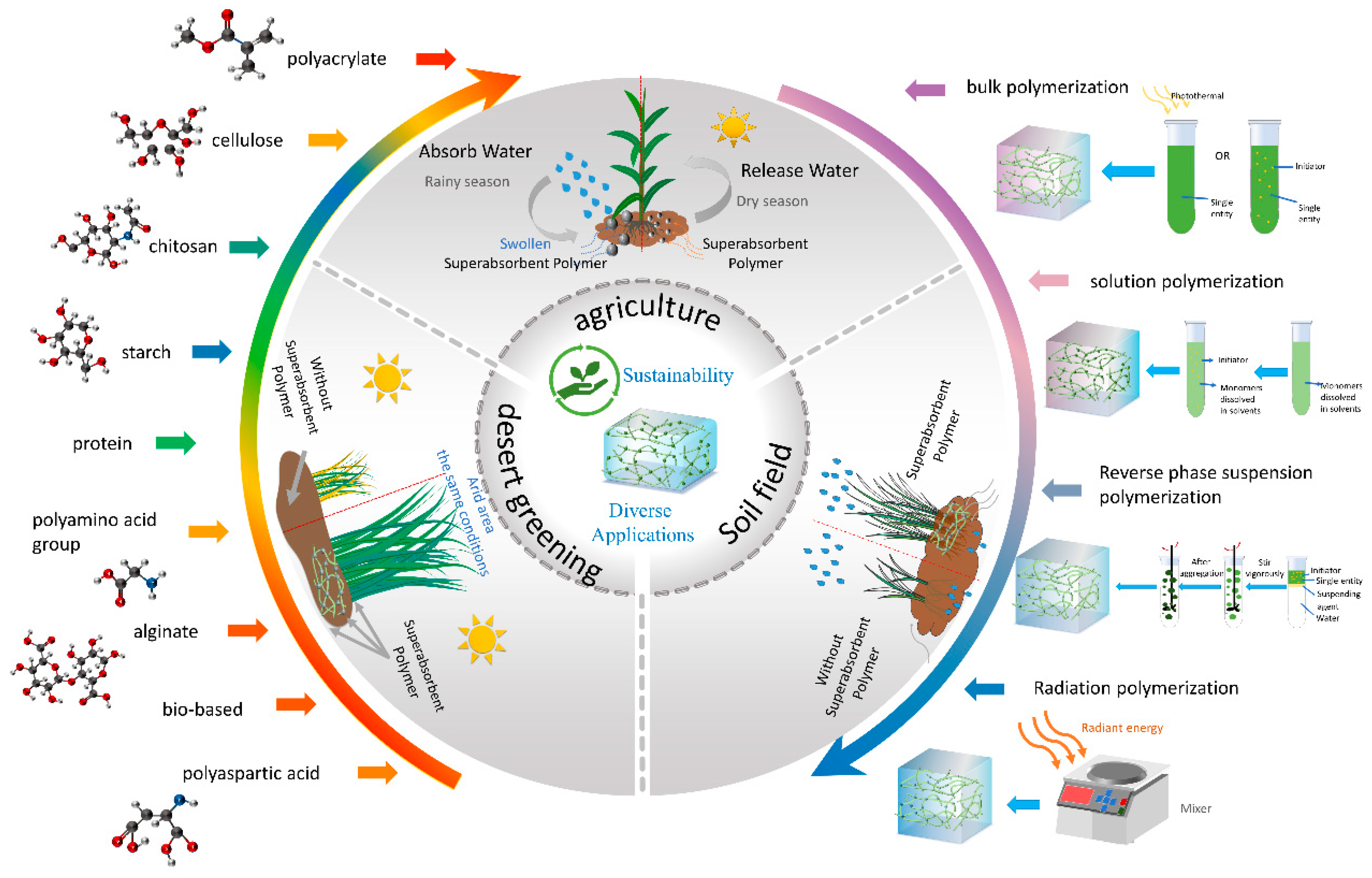
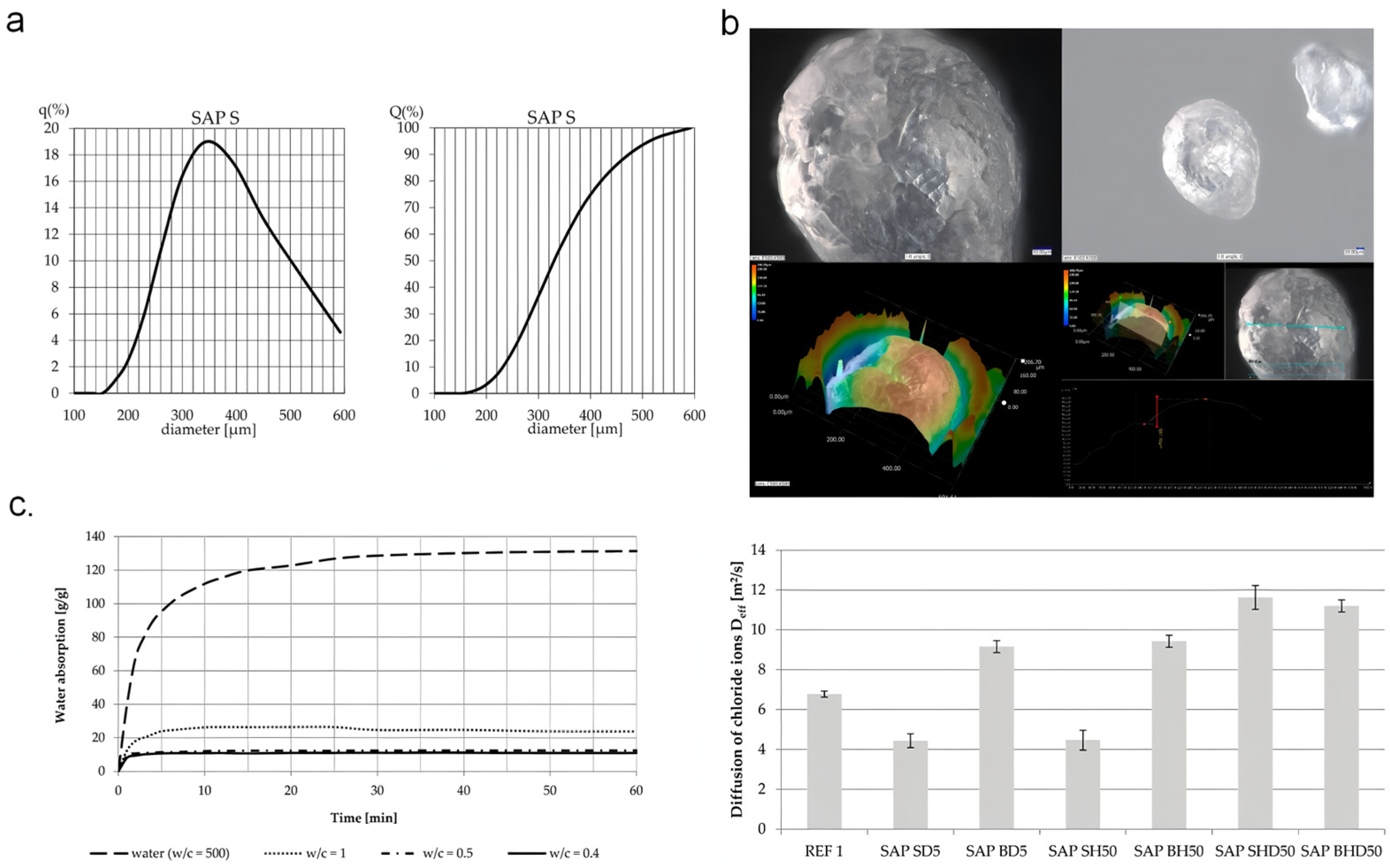

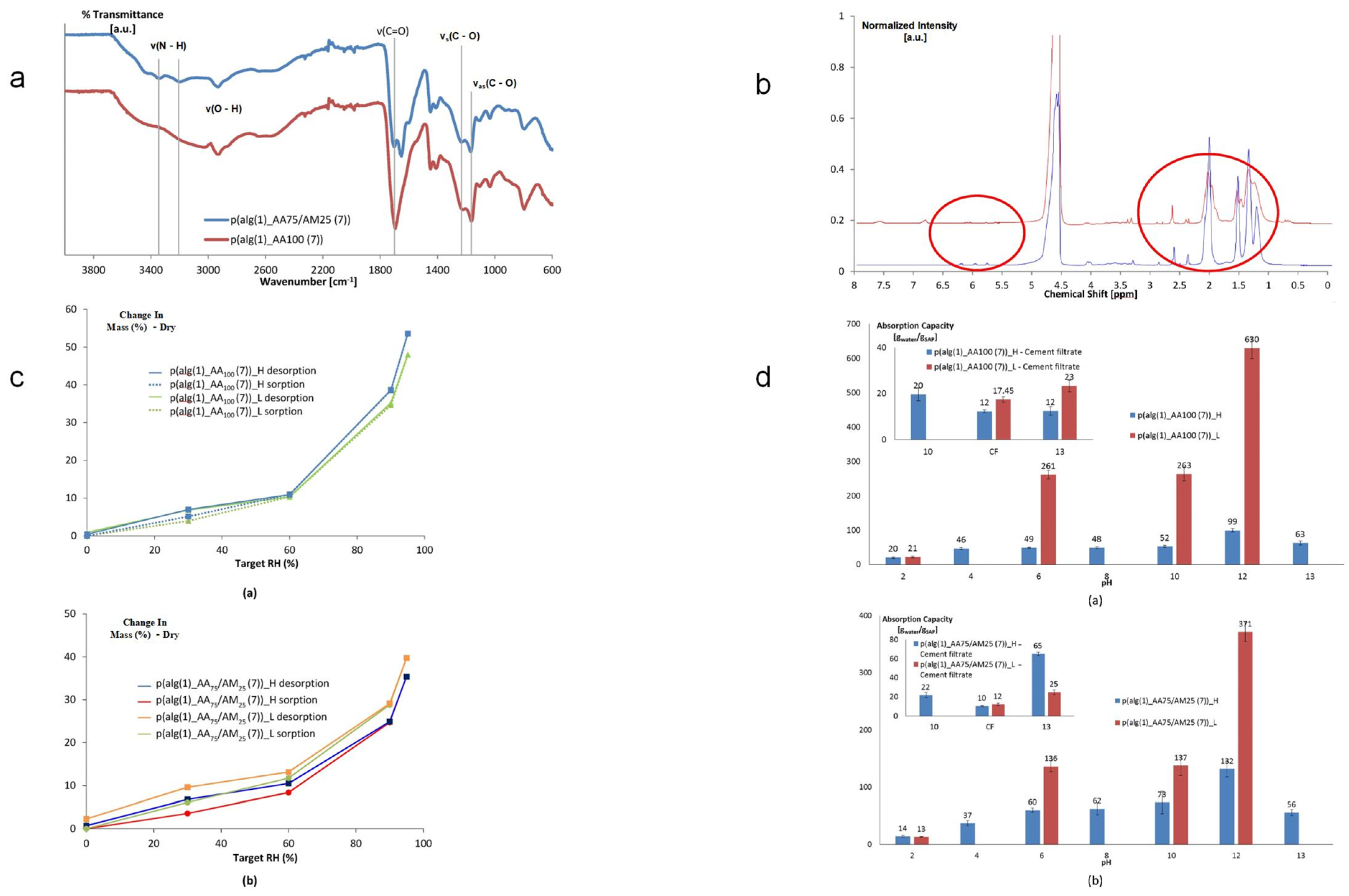


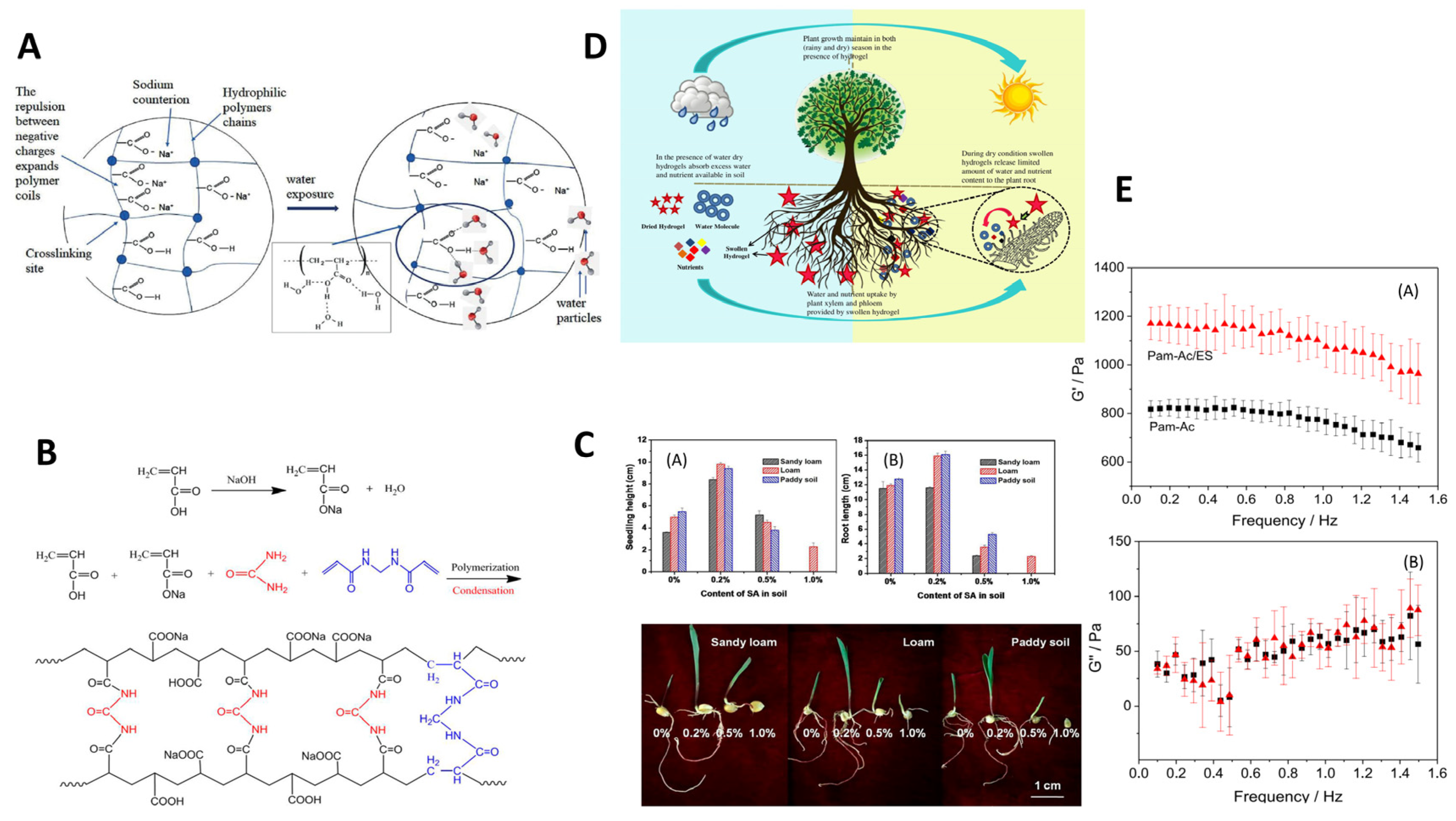
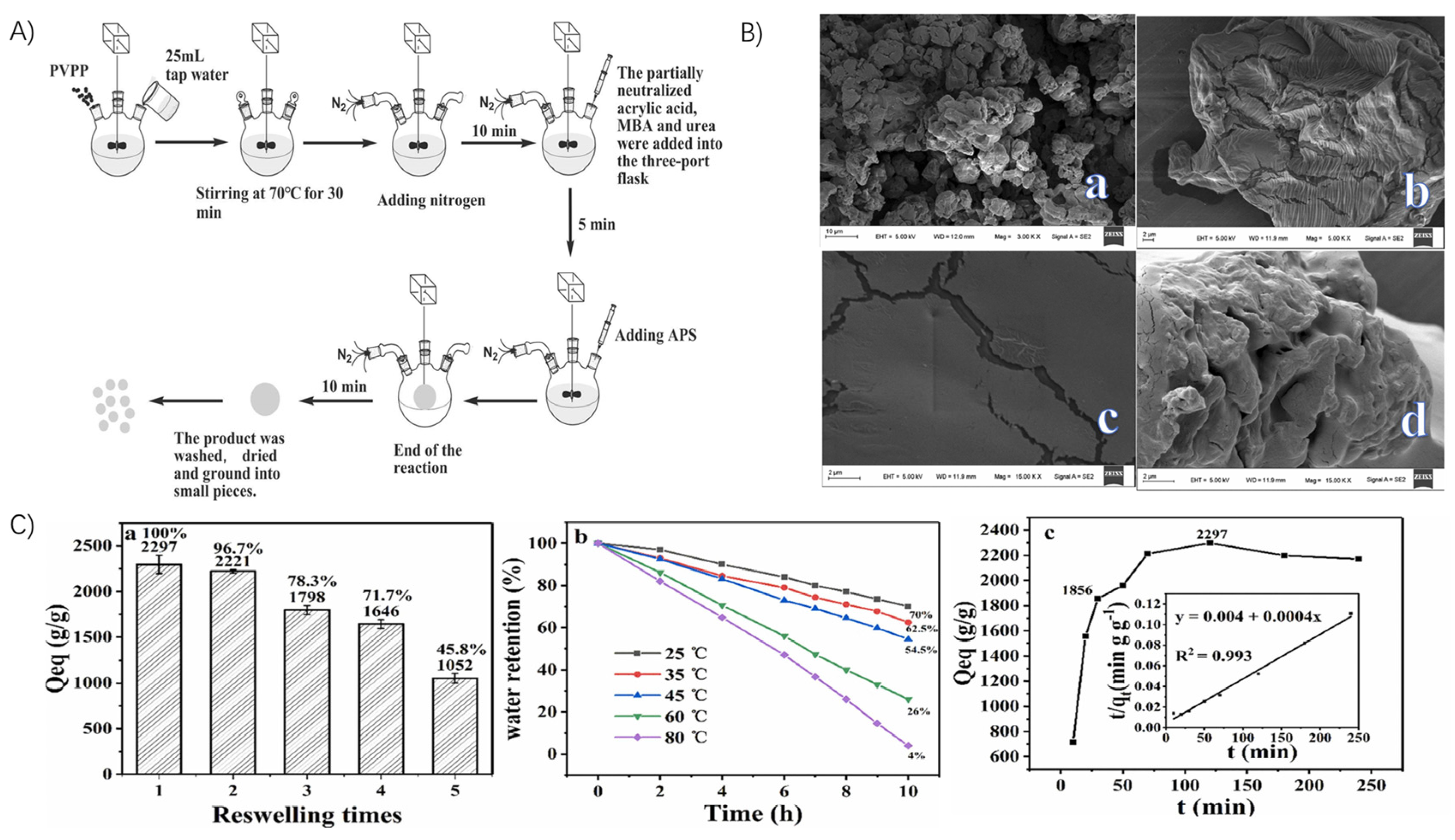
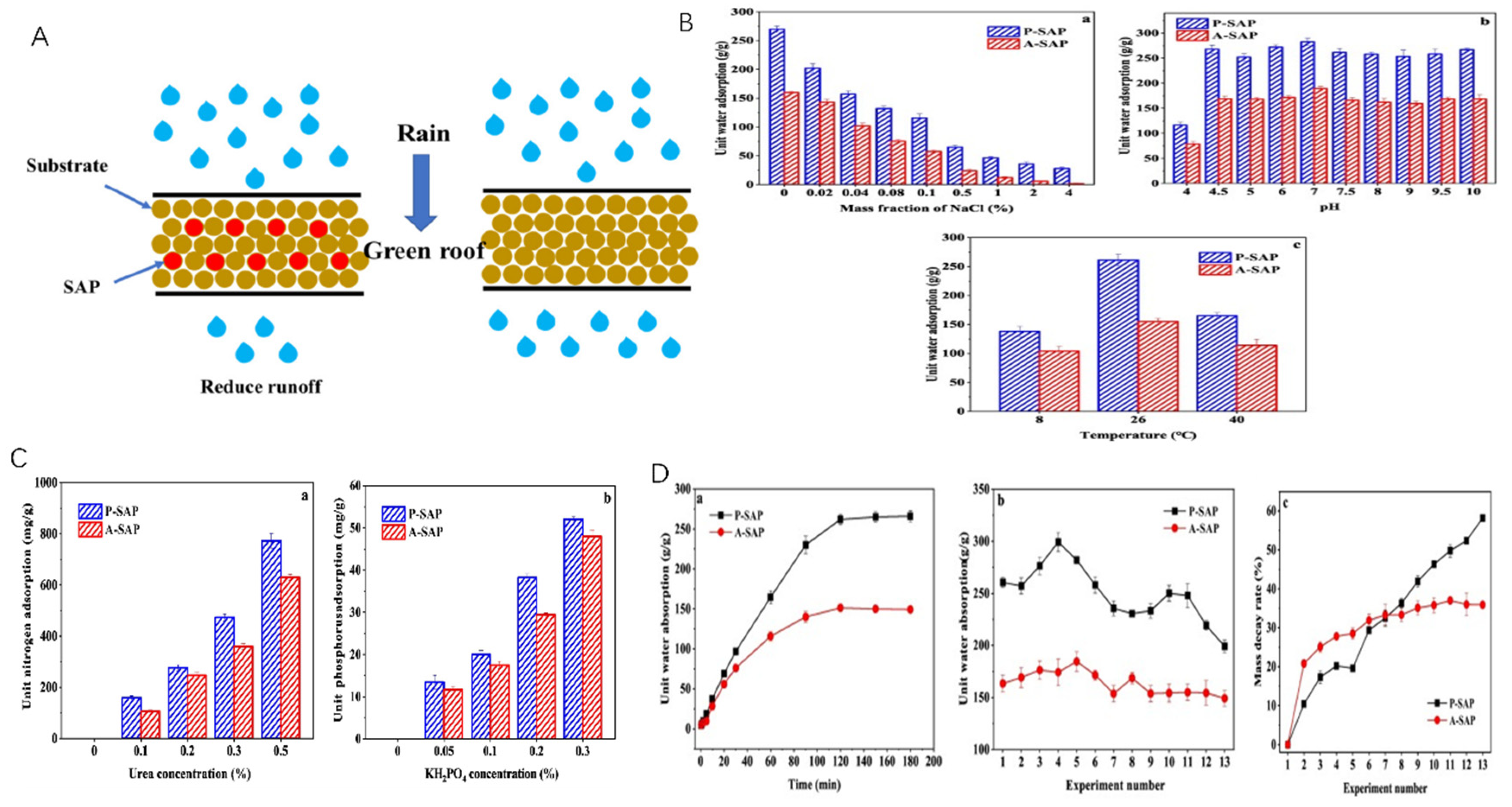
Disclaimer/Publisher’s Note: The statements, opinions and data contained in all publications are solely those of the individual author(s) and contributor(s) and not of MDPI and/or the editor(s). MDPI and/or the editor(s) disclaim responsibility for any injury to people or property resulting from any ideas, methods, instructions or products referred to in the content. |
© 2025 by the authors. Licensee MDPI, Basel, Switzerland. This article is an open access article distributed under the terms and conditions of the Creative Commons Attribution (CC BY) license (https://creativecommons.org/licenses/by/4.0/).
Share and Cite
Niu, Q.; Xie, J.; Li, J.; An, Z.; Xiao, H.; Zhang, X.; Su, Z.; Wang, Z. Superabsorbent Polymers: Innovations in Ecology, Environmental, and Diverse Applications. Materials 2025, 18, 823. https://doi.org/10.3390/ma18040823
Niu Q, Xie J, Li J, An Z, Xiao H, Zhang X, Su Z, Wang Z. Superabsorbent Polymers: Innovations in Ecology, Environmental, and Diverse Applications. Materials. 2025; 18(4):823. https://doi.org/10.3390/ma18040823
Chicago/Turabian StyleNiu, Qingya, Jiayin Xie, Jiayan Li, Zaixu An, Huijie Xiao, Xiaoyuan Zhang, Zhiqiang Su, and Zhichao Wang. 2025. "Superabsorbent Polymers: Innovations in Ecology, Environmental, and Diverse Applications" Materials 18, no. 4: 823. https://doi.org/10.3390/ma18040823
APA StyleNiu, Q., Xie, J., Li, J., An, Z., Xiao, H., Zhang, X., Su, Z., & Wang, Z. (2025). Superabsorbent Polymers: Innovations in Ecology, Environmental, and Diverse Applications. Materials, 18(4), 823. https://doi.org/10.3390/ma18040823






